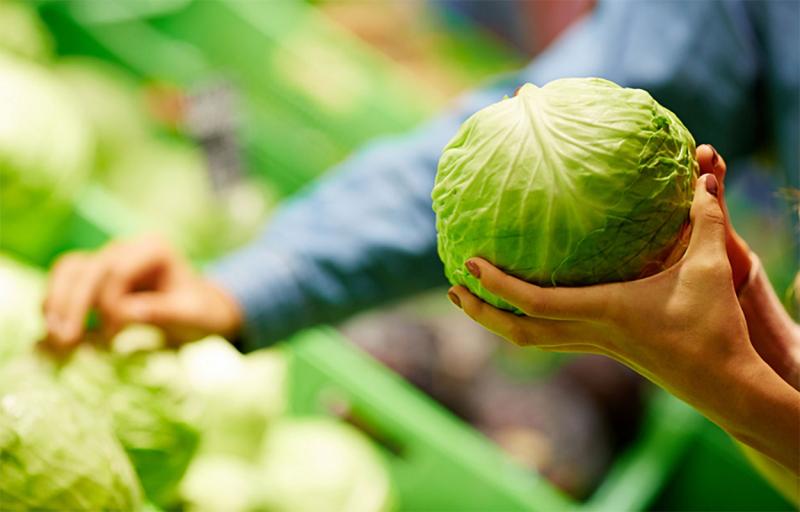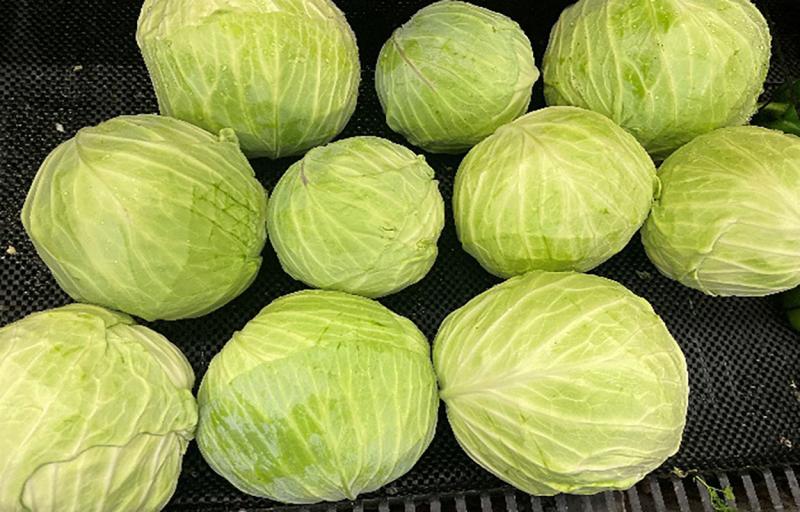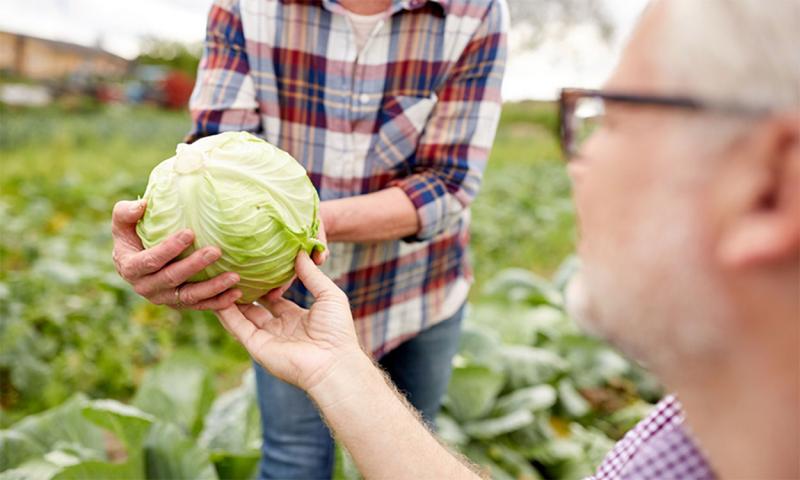
Written by Joslyn Fousert, SDSU Department of Agronomy, Horticulture and Plant Science Graduate Research Assistant, under the direction and review of Rhoda Burrows, former Professor & SDSU Extension Horticulture Specialist; and Kristine Lang.
Picture yourself walking into a grocery store, and right through the front door you are greeted by a beautiful assortment of produce sourced from a variety of producers. You find yourself gravitating towards the lush, green cabbage, as you have been planning to make some delicious homemade coleslaw. Your eyes are shifting from one head of cabbage to the next, making subconscious decisions on the color, size, shape, firmness, and how many blemishes seem acceptable. A moment of pause occurs in your mind as you decide on a head of cabbage and place it in your cart. A question begins to form in your mind as you look around observing other people similarly looking for perfect produce. You find yourself wondering, “Why is it that there are always such beautiful assortments of produce in grocery stores, and yet we are still so critical of the produce we take home at the end of the day?”
The goal of perfection in the assortments of produce in grocery stores is often a point of struggle for producers, as they know the imperfection story of their produce from production to harvest. Once a vegetable seedling and the elements of the world meet and mix, that cabbage is vulnerable to produce imperfections that are often not accepted by consumers. This frustration from a producer’s perspective is often understood well by home gardeners, who can look at a cabbage head with some holes in the leaves from cabbage loopers and understand the reasoning behind it. It is not wrong to have standards for the produce we consume and take home at the end of the day, as it offers a systematic way to reduce foodborne illnesses through increasing food safety expectations, which in turn increases cleanliness of produce placed on shelves. This article presents an opportunity to look at the U.S. Department of Agriculture (abbreviated as USDA) cabbage grading requirements, as they are key to understanding why produce is graded to certain standards before it ends up on grocery store shelves.
General Requirements

At this point in time the USDA has not issued size as a requirement of grades for cabbage. However, they do have some general requirements that both grade groups need to meet, which are outlined in this article. A harvested head needs to be firm, which will eliminate the risk of a consumer encountering a withered, puffy, or split head. The head also needs to be free from soft rot, seed stems and damage caused by discoloration, freezing, disease, insects, or mechanical damage. When looking at the cabbage head after the point of harvest, the stem needs to be cut to no more than one-half inch beyond the point of attachment of the outermost leaves. The outermost leaves, known as wrapper leaves, need to have no more than 4 wrapper leaves present to follow the well-trimmed requirement for all cabbage heads harvested. However, if the cabbage can be graded into the U.S. No. 1 Green or the U.S. No. 1. Red, then the number of wrapper leaves only need to be fairly well-trimmed, meaning no more than 7 wrapper leaves.
USDA Grading Requirements
U.S. No. 1 Grade
- Not more than 10%, by weight of the heads in any lot may fail to meet the above general requirements.
- Within the allotted 10%, no more than 2% may have soft decay.
- Excessive wrapper leaves 10%.
- Defects, other than excessive wrapper leaves 10%.
- Including soft decay 2%.
U.S. Commercial Grade
- Allows for an increased tolerance for defects beyond U.S. No. 1 grade cabbage heads.
- No more than 25% by weight of the heads in any lot may fail to meet the above requirements.
- Within the allotted 25%, no more than 10% may have defects causing serious damage.
- Within the above allotted 10%, not more than 2% may have soft decay.
- Excessive wrapper leaves 10%.
- Defects, other than excessive wrapper leaves 25%.
- Including serious damage 10%.
- Including soft decay 2%.
- Including serious damage 10%.
Quality and Conditions to Consider

Cabbage standards focus on quality in the areas of cleanness, color, firmness, hollow stems, mechanical damage, seed stems, similar variety characteristics, sunscald, and trimming. The requirement of the condition also has various focuses through watching for Alternaria leaf spot/black leaf speck, black rot, bruising, freshness, tipburn, yellowing and discoloration, freezing/injury and soft rot. Aspects of both quality and condition are pulled together through watching for insect and worm damage, along with split heads.
Next Time You Shop
Overall, when looking at produce selections on grocery store shelves, it is important to remember that there is a vast abundance of produce from the original harvest that did not make it onto the shelves for various reasons. No one wants to buy a cabbage head with mechanical damage, burst heads, and insect or animal damage. However, if anything, it is key to remember that USDA standards are not present to make producers’ struggles against the elements of the world even more difficult, rather they exist to guide a healthy, well-intended supply for consumers with a systematic approach. It is key to look at the quality and conditions of produce to allow for consumer expectations to be guided to an understanding of health and cleanliness with produce choices.
References and Resources
- Cabbage Grades and Standards, USDA Agricultural Marketing Service.
- Shipping Point and Market Inspection Instructions, USDA Agricultural Marketing Service.


